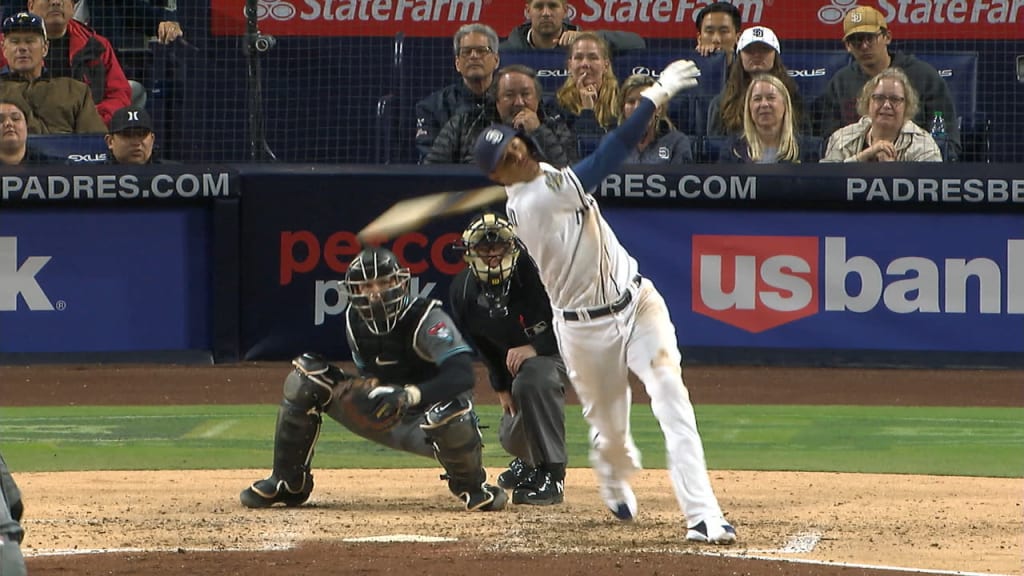Greinke throws a 'slowball' -- and it's amazing
This browser does not support the video element.
Zack Greinke is doing something beautiful. He's throwing rainbows, and making the Major League hitters who swing at them look for a glorious moment like they belong anywhere but a batter's box.
Greinke's Bugs Bunny curveball is one of the game's most aesthetically pleasing pitches -- cartoonishly slow, often floating in barely over 60 mph -- and it induces some of the most cartoonishly hopeless swings that you'll see from a hitter at baseball's highest level.
It's a modern-day descendent of the true eephus, baseball's iconic lob pitch made famous by Rip Sewell in the 1940s. But it's more than an eye-candy thrill for fans. Greinke's eephus curve has been integral to the late-career adaptation of one of MLB's canniest pitchers. And the fact that he's doing this in the golden age of velocity only makes it sweeter.
Greinke, at age 35 and with a fastball that now sits in the high 80s, has a 2.78 ERA and 0.876 WHIP through 12 starts this season. Already cemented as one of the best pitchers of his generation, Greinke has reinvented himself to continue to pitch brilliantly. He paints the edges. He's a master of pitch mix and sequencing, throwing hitters off-kilter. And he throws eephus curves.
This season, Greinke has thrown 80 pitches under 70 mph. That's by far the most of any pitcher. In fact, the next-closest "pitcher" is Greinke's own teammate, John Ryan Murphy ... who you might recognize as a catcher. Murphy, designated for assignment last week, pitched in two blowouts, and just lobbed the ball in. Greinke's thrown nearly double the sub-70 mph pitches as the next-closest true pitcher, Oakland's Chris Bassitt, who's thrown 45.
But here's the best part. In the at-bats decided on those sub-70 mph eephus-like curves, hitters are 0-for-31 with 12 strikeouts. On about three-fourths of the 80 slow curves he's thrown in total, Greinke has gotten either a strike (called, swinging or foul) or an out on a ball in play.
That's right -- hitters are hitless against the slowest of Greinke's slow curves. They've been unable to figure out a curveball that comes in, on average, at 69.3 mph -- a speed range almost no pitchers in the Majors dip into. This is no gimmick. It's an honest weapon, especially with two strikes, when Greinke's especially likely to throw the slow curve now compared to years past.
Most pitches thrown under 70 mph, 2019
1) Zack Greinke (ARI): 80
2) John Ryan Murphy (ARI): 63 (Position player)
3) Chris Bassitt (OAK): 45
4) Ryne Harper (MIN): 43
5) Patrick Corbin (WSH): 37
Greinke's eephus curve isn't a new pitch. He's had it at his disposal since at least the beginning of the decade. But in the last couple of seasons, as he beguiles hitters into his mid-30s, he's started to integrate it more deeply into his repertoire.
For most of the pitch-tracking era, which began in 2008, Greinke's slow-curve usage hovered around one to two percent of his total pitches thrown. But by 2018, 6.6 percent of his pitches were sub-70 mph easily establishing a career high. This year, he's raised the number again, to 6.8 percent. And as he's increased his eephus curve use to its highest level yet, the pitch has attained its highest level of effectiveness.
Greinke's eephus curve through the years
Seasons with highest % sub-70 mph + BA and K
2009: 2.9% slow curves, .421 BA (8-for-19, 1 K)
2011: 4.9% slow curves, .258 BA (8-for-31, 2 K)
2014: 2.1% slow curves, .211 BA (4-for-19, 6 K)
2018: 6.6% slow curves, .103 BA (9-for-87, 37 K)
2019: 6.8% slow curves, .000 BA (0-for-31, 12 K)
Greinke will throw the slowball against anybody. He'll throw it to elite sluggers like Gary Sanchez (whose excuse-me swing couldn't have come any later).
He'll throw it to superstars like Manny Machado (spin-o-rama swing-and-miss at 69.8 mph).
He'll even throw it to pitchers bunting with two strikes (just ask the Padres' Matt Strahm).
And the hacks. Just look at the awkward hacks. Greinke can catch even the best hitters wildly off-guard.
On top of all that, there's the final layer that this is happening in 2019, when pitchers are nastier than ever before largely because they're throwing harder than ever before, at all points across their arsenals.
In 2019, pitchers pair 99 mph heaters with 92 mph sliders designed in labs. They ramp up mid-80s curveballs with 3,000-plus rpm spin rates. The fifth guy out of a team's bullpen throws breaking balls harder than most pitchers' fastballs used to be.
And Greinke is out there striking people out with lollipops. How could you not love it?
